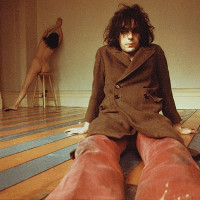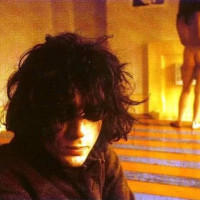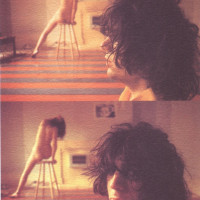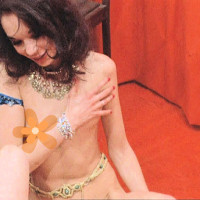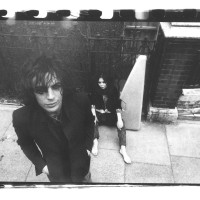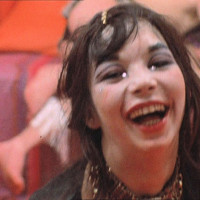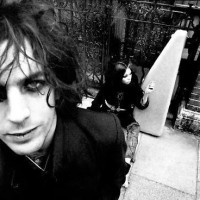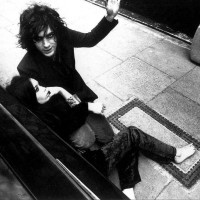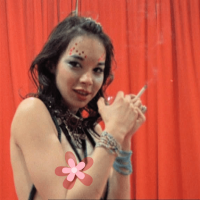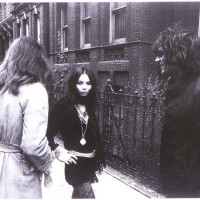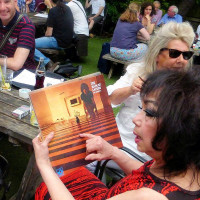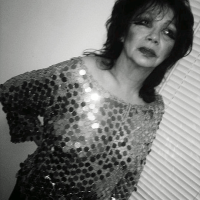January 1970 saw the release of The Madcap Laughs, Syd Barrett’s first solo album. There are a few mysteries concerning the album cover. Mick Rock claimed (in the film Shot!) that he was behind the photo shoot, whereas Storm Thorgerson claimed it was his work. There have been contradictory testimonies as well regarding the shooting date. In The Making Of The Madcap Laughs, Malcolm Jones puts it around October–November 1969, and other witnesses eagerly confirmed this without giving it a second thought. Fan investigations in 2009, with the help of Jenny Spires, pinned the Madcap photo shoot around April 1969, a date that is now generally accepted.
Turning the album cover around shows another picture of Syd Barrett in his flat. It is a picture that is perhaps even more mythical.
Syd is crouching down. Behind him is a silhouette of a naked woman, leaning on a stool. Because of the poor lighting conditions (the shots were taken without a flash), the picture is grainy and has what Storm called an “upgraded colour transparency.”
The identity of the woman was unknown for quite a while, but in the Crazy Diamond biography by Mike Watkinson and Pete Anderson, she is somewhat disrespectfully described as a destitute half-Eskimo named Iggy.
Iggy wasn’t a new face in the crowd. She had been around for a couple of years in rock circles and was one of the familiar hangers-on in the hipper nightclubs of swinging London. Pink Floyd biographer Mark Blake describes her pretty accurately as a Zelig-like presence on the capital’s music scene in the sixties.
Iggy was born Evelyn Joyce on December 14th, 1947 in Rawalpindi. A couple of months before, British India had split in two, and her birthplace was now lying in the dominion of Pakistan. Her father, Harry Charlton Joyce, was an officer in the British army. Her mother, Angela Chawngpuii, was a member of the Mizo people, located in the northeastern regions of India. From the Mizo branch of the family, Iggy also received an indigenous name: Laldawngliani. Iggy would never use the word “Pakistan”, as the country was taboo in the family.
The Indian subcontinent wasn’t a politically stable region, and the family had to flee when protesters attacked their mansion. The family relocated to the colony of Aden (Yemen), another unstable region.
After that, the family settled in Great Britain. Iggy received a ‘traditional’ ladylike upbringing with tutors who taught her to play musical instruments, like the violin. She had a voice coach and took ballet classes, but not to much avail.
Iggy had something of a rebellious character, running away from home for undisclosed reasons. She was in Brighton during the Mods vs Rockers war, although it is not certain which side she was on. Around 1963, she arrived in London, where she frequented the Orchid dancehall in Purley. One of the house DJs was Jeff Dexter, who was immediately captivated by her appearance.
She was nicknamed “Iggy the Eskimo” around that time, emphasising her mysterious nature and her enchanting looks. The fact that she was a “free spirit” certainly helped her introduction to the pop-culture royals of those days. She entered the inner circle of The Rolling Stones through Stanislas Kossowski de Rola and befriended Brian Jones and Anita Pallenberg. She attended the Sympathy For The Devil sessions, was on the Performance movie-set but missed the party at Keith Richard’s 15th century Redlands country house, which was raided by the police, simply because she had lost her way.
For a while, she had a love interest in Eric Clapton. He was a serial womanizer who didn’t keep his sweet promises, and her world was shattered when she saw him entering the Speakeasy with Alice Ormsby-Gore by his side.
In the heydays of psychedelia, Iggy frequented the higher strata of the London underground. Her classic upbringing meant that she could mingle with aristocrats, musicians, writers, actors, photographers, and movie-makers. She was basically poor and homeless, asking for a meal and a bed for the night whenever possible. One anecdote goes that she left a Rolling Stones party to go ‘home’, slept on the street, and returned to the still ongoing party in the morning to have breakfast.
Iggy dreamt of a career as a model, but lacked the willpower to make it happen. She could easily have forced her way into some form of stardom or have had an easy life at the side of a celebrity, but she, sometimes literally, ran away when opportunity knocked. Other than, for instance, Uschi Obermaier, she didn’t turn a date with Jimi Hendrix into front-page news or use her Keith Richards connections to get into the jet-set. She was too shy to model for Ossie Clark, who asked her to and refused a minor role in Performance, backed-up by Anita Pallenberg and Myriam Gibril.
Iggy was gullible, naively trusting people who promised her golden mountains. There were people, like Anthony Stern and Jeff Dexter, who meant well, but others just took advantage. Underground prophets, mostly men, have written pink-tinted memories about the sexual revolution. Others, mostly women, have debunked the movement as inherently female unfriendly.
For a couple of years, Iggy frequented the underground elite, even going on an Arthurian quest to Port Eliot in a horse-driven cart, led by an eccentric millionaire and his wacky followers.
It isn’t certain how Iggy fell out with the British kings of rock ‘n’ roll and descended a couple of floors in the underground picking order. Rock was becoming more professional, and musicians would keep their personal lives hidden from prying eyes.It also needs to be said that Iggy followed the trail where drugs led her. Iggy was addicted to speed and would be for the rest of her life.
Jenny Spires met Iggy at Biba. They went to a Dusty Springfield party, and Spires returned the favour by introducing her to Syd Barrett, around February–March 1969. Syd and Iggy had a relationship that was more than the ‘girlfriend of the week’ stage that some people have made of it, but it would probably go too far to define her as an ‘official’ girlfriend.
There were some amorous feelings, though. Iggy has witnessed how she followed Barrett to David Gilmour’s flat, jealously thinking he was cheating on her. There is also the story of how Barrett wanted to give her a baby, which made her panic.
Iggy wasn’t staying all the time in Barrett’s flat, but she may have been there, on and off, for a couple of months. Gretta Barclay has said she was still around in June. In early August, Syd, Iggy, Twink, and Took went to a King Crimson gig at the Speakeasy, where they created a scandal.
By then, Iggy was hanging around with the ‘Pink Fairies All-Star Rock’n’Roll Show & Motorcycle Circus’, an informal drinking club including Barrett, Mick Farren, Lemmy, Twink, and Steve Peregrine Took, whom she lived with for a while.
Iggy has told how she rang at Wetherby Mansions one day and was told by Duggie Fields: “Syd doesn’t live here any more.” It is believed Syd left his flat for Cambridge after the Barrett sessions. This may have happened in the late summer of 1970.
Iggy didn’t mysteriously vanish all of a sudden. She disappeared from the Floyd’s radar and moved down the King’s Road to Pont Street Mews, Knightsbridge. There was a pretty serious relationship with Simon Thompson, a Scientologist who belonged to a wealthy family. Duggie Fields remarked that she suddenly looked a lot more ‘sloaney’. It was rumoured that she had married this banker and was living the good life.
This relationship also ended, and Iggy carried on, meeting actors like John Myers and experimental moviemakers from the London Film-Makers’ Co-op. Her big break had to come when she had one of the leading roles in an avant-garde film. Unfortunately, people left the movie–theatre faster than they had entered.
In the late seventies, Iggy had to look for a job. She found one at a horse farm where she met her husband, Andy Rose, who incidentally reminded her of Rod Stewart. They married and lived in a small village in West Sussex.
For three decades, Iggy lived a relatively anonymous life that was only occasionally disturbed by people who recognised her from her underground days. For a while, she worked at a local supermarket, but her flamboyant character was not compatible with the management. They had to let her go.
There has always been some anoraky interest in the unknown woman at the backside of the Madcap Laughs album. In 2008, one of Syd’s old friends, photographer Anthony Stern, showed the “Iggy the Eskimo Girl” film and his Iggy triptychs during the City Wakes festival in Cambridge. Around that time, a fan website, ‘The Holy Church of Iggy the Inuit’ was launched, and the local newspaper, The Croydon Guardian, had an article on her.
Music magazine Mojo had a Syd Barrett special in 2010. The article, ‘Who’s That Girl’, written by Pink Floyd biographer Mark Blake, triggered a reader to give away Iggy’s whereabouts. Soon after, she joined social media and became a popular figure in Syd Barrett’s Facebook circles, befriending fans all over the world and always eager to answer their questions. She very much liked the attention given to her, and this was not always appreciated by other, more ‘serious” witnesses from the Barrett-sphere who disapproved of her flamboyancy.
A deteriorating health forced Iggy to leave social media in 2016. She died on the 13th of December 2017, just before her seventieth birthday. Those who knew her during the five years she was a member of dozens of Facebook groups will remember her fondly.


